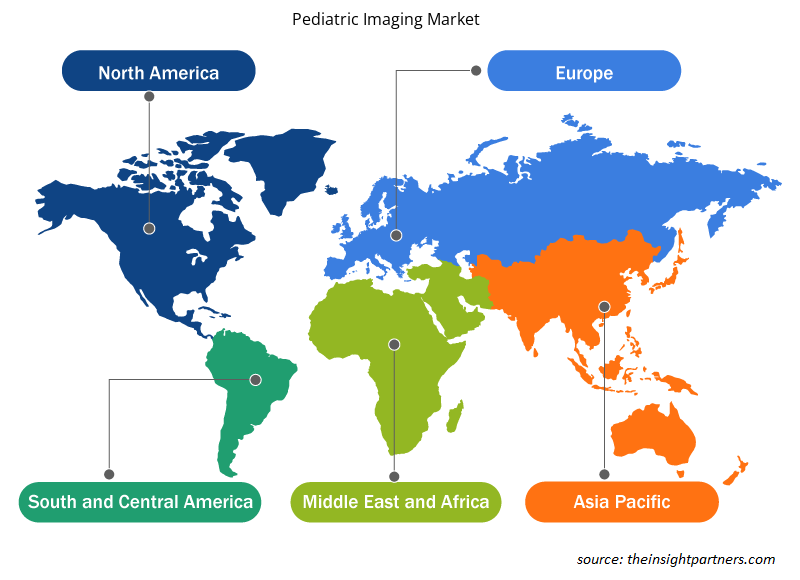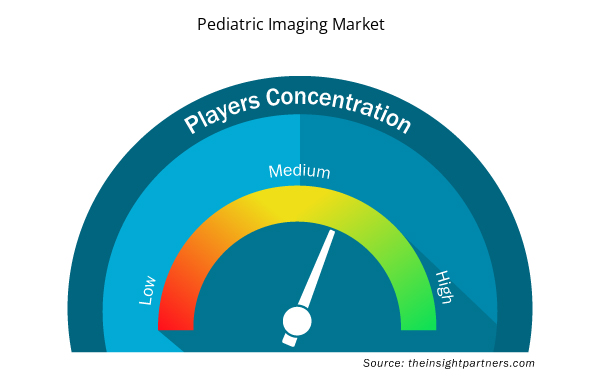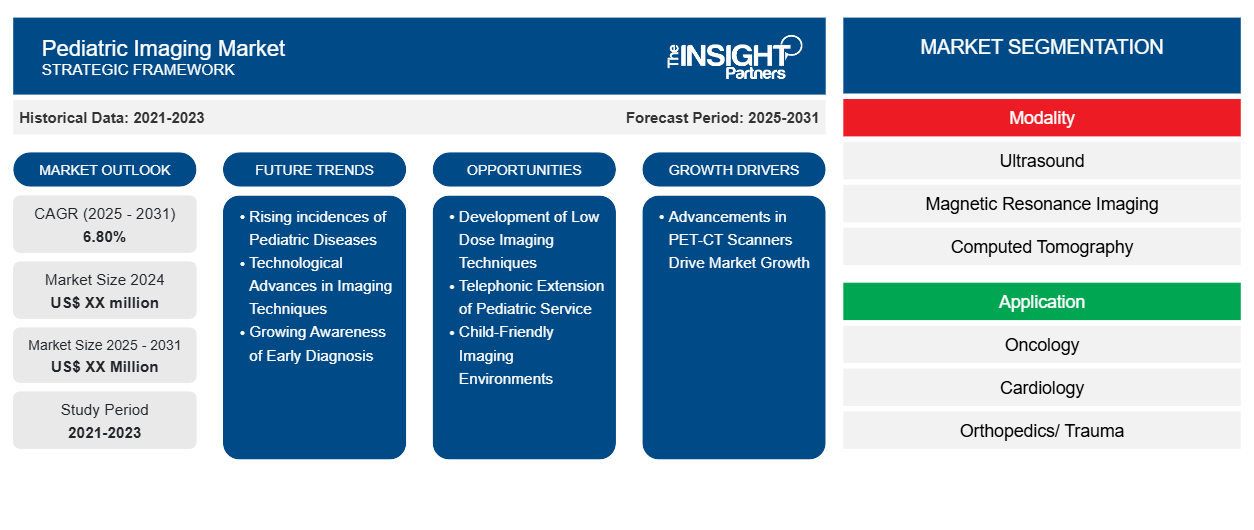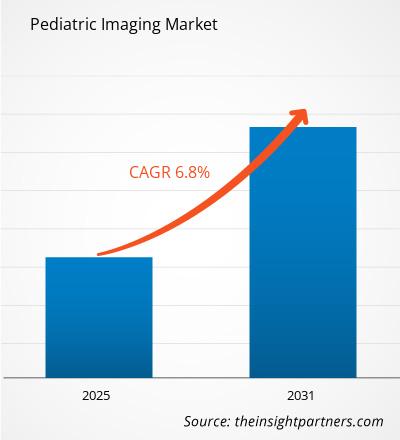Le marché de l'imagerie pédiatrique devrait enregistrer un TCAC de 6,80 % de 2023 à 2031, avec une taille de marché passant de XX millions USD en 2023 à XX millions USD d'ici 2031.
Le rapport présente une analyse basée sur la modalité (échographie, imagerie par résonance magnétique (IRM), tomodensitométrie (TDM), radiographie, autres). Le rapport fournit en outre une analyse basée sur l'application (oncologie, cardiologie, orthopédie/traumatologie, gastroentérologie, neurologie et autres) et sur l'utilisation finale (hôpitaux, centres de diagnostic et autres). L'analyse mondiale est ensuite décomposée au niveau régional et par principaux pays. La taille du marché et les prévisions aux niveaux mondial, régional et national pour tous les segments de marché clés sont couvertes dans le cadre du périmètre. Le rapport offre la valeur en USD pour l'analyse et les segments ci-dessus. Le rapport fournit des statistiques clés sur l'état du marché des principaux acteurs du marché et offre des tendances et des opportunités de marché.
Objectif du rapport
Le rapport sur le marché de l'imagerie pédiatrique de The Insight Partners vise à décrire le paysage actuel et la croissance future, les principaux facteurs moteurs, les défis et les opportunités. Cela fournira des informations à diverses parties prenantes commerciales, telles que :
- Fournisseurs/fabricants de technologie : pour comprendre l’évolution de la dynamique du marché et connaître les opportunités de croissance potentielles, leur permettant de prendre des décisions stratégiques éclairées.
- Investisseurs : Effectuer une analyse complète des tendances concernant le taux de croissance du marché, les projections financières du marché et les opportunités qui existent tout au long de la chaîne de valeur.
- Organismes de réglementation : Réglementer les politiques et surveiller les activités du marché dans le but de minimiser les abus, de préserver la confiance des investisseurs et de maintenir l’intégrité et la stabilité du marché.
Segmentation du marché de l'imagerie pédiatrique
Modalité
- Ultrason
- Imagerie par résonance magnétique
- Tomodensitométrie
- radiographie
- Autres
Application
- Oncologie
- Cardiologie
- Orthopédie/ Traumatologie
- Gastroentérologie
- Neurologie
- Autres
Utilisation finale
- Hôpitaux
- Centres de diagnostic
- Autres
Géographie
- Amérique du Nord
- Europe
- Asie-Pacifique
- Amérique du Sud et Amérique centrale
- Moyen-Orient et Afrique
Géographie
- Amérique du Nord
- Europe
- Asie-Pacifique
- Amérique du Sud et Amérique centrale
- Moyen-Orient et Afrique
Personnalisez ce rapport en fonction de vos besoins
Vous bénéficierez d'une personnalisation gratuite de n'importe quel rapport, y compris de certaines parties de ce rapport, d'une analyse au niveau des pays, d'un pack de données Excel, ainsi que d'offres et de remises exceptionnelles pour les start-ups et les universités.
- Obtenez les principales tendances clés du marché de ce rapport.Cet échantillon GRATUIT comprendra une analyse de données, allant des tendances du marché aux estimations et prévisions.
Facteurs de croissance du marché de l'imagerie pédiatrique
- Advancements in PET-CT Scanners Drive Market Growth: Continual improvements to PET-CT scanners in aspects such as resolution and speed have, and will continue to tangibly drive market expansion. Greater sensitivity ensures more accurate detections of small tissues, improved resolution ensures greater comfort for the patient in relation to waiting for the procedure, whereas improvements in the other areas will allow for future devices such as between-healthcare innovations in clinical practice.
Pediatric Imaging Market Future Trends
- Rising incidences of Pediatric Diseases: Increasing prevalence of the diseases among small children such as congenital disorders and cancers is the factor pushing advanced imaging solutions at the moment. Focus has shifted to high-resolution imaging technologies that, for example, include MRI and CT scans that manage complex diagnoses, making demands essential for health providers and consequently facilitating growth in the market.
- Technological Advances in Imaging Techniques : New imaging technologies such as 3D and 4D imaging have endowed with diagnostic features to pediatric patients. Such modernizations can now enable the resultant accurate health conditions of children with minimum exposition to any radiation. The progressive improvement of imaging equipment continues to hold the key toward enhancing patient outcomes yet more also expanding the pediatric imaging market.
- Growing Awareness of Early Diagnosis: Rising Awareness of Parents and Health Professionals over Importance of Early Diagnosis Makes a Very Significant Difference in Pediatric Imaging. Following the early screening of health issues comes timely intervention, resulting in enabling the health providers to procure advanced imaging technologies relevant to pediatric patients.
Pediatric Imaging Market Opportunities
- Development of Low Dose Imaging Techniques: There is also the trend towards more low-dose imaging modalities for the pediatric population to reduce radiation dose. Manufacturers have therefore invented much safer imaging machines to use in the accurate diagnosis of patients without compromising safety. That is an encouraging trend toward the well-being of a child concerning health considerations in effective medical evaluations.
- Telephonic Extension of Pediatric Service: Telemedicine is the new emerging way of serving patients with pediatric imaging. Their children can physically stay elsewhere but have similar services as they assess and treat patients virtually through consultations and follow-ups. This is part of the improved accessibility to specialty care that has been prioritized for families in rural and underserved areas, thus further fueling the need for pediatric imaging solutions.
- Child-Friendly Imaging Environments: Making kid-friendly imaging environments is one of the upcoming trends in a pediatric imaging market. Facilities put major efforts to offer such welcoming spaces and visual distractions with comfier amenities that would reduce anxiety among small patients. This trend would improve the overall experience for children who undergo imaging procedures.
Pediatric Imaging Market Regional Insights
The regional trends and factors influencing the Pediatric Imaging Market throughout the forecast period have been thoroughly explained by the analysts at Insight Partners. This section also discusses Pediatric Imaging Market segments and geography across North America, Europe, Asia Pacific, Middle East and Africa, and South and Central America.

- Get the Regional Specific Data for Pediatric Imaging Market
Pediatric Imaging Market Report Scope
| Report Attribute | Details |
|---|---|
| Market size in 2023 | US$ XX million |
| Market Size by 2031 | US$ XX Million |
| Global CAGR (2023 - 2031) | 6.80% |
| Historical Data | 2021-2022 |
| Forecast period | 2024-2031 |
| Segments Covered | By Modality
|
| Regions and Countries Covered | North America
|
| Market leaders and key company profiles |
|
Pediatric Imaging Market Players Density: Understanding Its Impact on Business Dynamics
The Pediatric Imaging Market market is growing rapidly, driven by increasing end-user demand due to factors such as evolving consumer preferences, technological advancements, and greater awareness of the product's benefits. As demand rises, businesses are expanding their offerings, innovating to meet consumer needs, and capitalizing on emerging trends, which further fuels market growth.
Market players density refers to the distribution of firms or companies operating within a particular market or industry. It indicates how many competitors (market players) are present in a given market space relative to its size or total market value.
Major Companies operating in the Pediatric Imaging Market are:
- GE Healthcare
- Philips Healthcare
- Toshiba Medical Systems Corporation
- Siemens Healthcare
- Mindray Medical International Limited
Disclaimer: The companies listed above are not ranked in any particular order.

- Get the Pediatric Imaging Market top key players overview
Key Selling Points
- Comprehensive Coverage: The report comprehensively covers the analysis of products, services, types, and end users of the Pediatric Imaging Market, providing a holistic landscape.
- Analyse d’experts : Le rapport est compilé sur la base d’une compréhension approfondie des experts et analystes du secteur.
- Informations à jour : Le rapport garantit la pertinence commerciale en raison de sa couverture des informations récentes et des tendances des données.
- Options de personnalisation : ce rapport peut être personnalisé pour répondre aux exigences spécifiques du client et s'adapter parfaitement aux stratégies commerciales.
Le rapport de recherche sur le marché de l’imagerie pédiatrique peut donc aider à ouvrir la voie au décodage et à la compréhension du scénario de l’industrie et des perspectives de croissance. Bien qu’il puisse y avoir quelques préoccupations valables, les avantages globaux de ce rapport ont tendance à l’emporter sur les inconvénients.
- Analyse historique (2 ans), année de base, prévision (7 ans) avec TCAC
- Analyse PEST et SWO
- Taille du marché Valeur / Volume - Mondial, Régional, Pays
- Industrie et paysage concurrentiel
- Ensemble de données Excel


- Cling Films Market
- Electronic Health Record Market
- Blood Collection Devices Market
- Excimer & Femtosecond Ophthalmic Lasers Market
- Semiconductor Metrology and Inspection Market
- Sleep Apnea Diagnostics Market
- Railway Braking System Market
- Formwork System Market
- Human Microbiome Market
- Investor ESG Software Market

Report Coverage
Revenue forecast, Company Analysis, Industry landscape, Growth factors, and Trends

Segment Covered
This text is related
to segments covered.

Regional Scope
North America, Europe, Asia Pacific, Middle East & Africa, South & Central America

Country Scope
This text is related
to country scope.
Questions fréquemment posées
Asia Pacific region expected to witness fastest growth during the forecast period
North America region dominated the Pediatric Imaging Market in 2023
CooperSurgical, MedGyn, Personal Medical Corp, Integra LifeSciences, Smiths Medical accounting for higesh market shares and are some of the major players operating in the market
The major factors driving the Pediatric Imaging Market are:
1.Rising Prevalence of Pelvic Organ Prolapse (POP)
2. Stress Urinary Incontinence
3. Growing Awareness and Acceptance
The Ring Pessary segment accounts for highest revenue in product the Pediatric Imaging Market in 2023
The Pediatric Imaging Market is estimated to witness a CAGR of 6.80% from 2023 to 2031
Trends and growth analysis reports related to Life Sciences : READ MORE..
1. GE Healthcare
2. Philips Healthcare
3. Toshiba Medical Systems Corporation
4. Siemens Healthcare
5. Mindray Medical International Limited
6. Samsung Medison Co. Ltd
7. Fujifilm Holdings Corporation
8. Agfa Healthcare
9. Carestream Health, Inc.
10. Analogic Corporation
11. Esaote SpA
12. Hitachi, Ltd
13. Canon, Inc
The Insight Partners performs research in 4 major stages: Data Collection & Secondary Research, Primary Research, Data Analysis and Data Triangulation & Final Review.
- Data Collection and Secondary Research:
As a market research and consulting firm operating from a decade, we have published and advised several client across the globe. First step for any study will start with an assessment of currently available data and insights from existing reports. Further, historical and current market information is collected from Investor Presentations, Annual Reports, SEC Filings, etc., and other information related to company’s performance and market positioning are gathered from Paid Databases (Factiva, Hoovers, and Reuters) and various other publications available in public domain.
Several associations trade associates, technical forums, institutes, societies and organization are accessed to gain technical as well as market related insights through their publications such as research papers, blogs and press releases related to the studies are referred to get cues about the market. Further, white papers, journals, magazines, and other news articles published in last 3 years are scrutinized and analyzed to understand the current market trends.
- Primary Research:
The primarily interview analysis comprise of data obtained from industry participants interview and answers to survey questions gathered by in-house primary team.
For primary research, interviews are conducted with industry experts/CEOs/Marketing Managers/VPs/Subject Matter Experts from both demand and supply side to get a 360-degree view of the market. The primary team conducts several interviews based on the complexity of the markets to understand the various market trends and dynamics which makes research more credible and precise.
A typical research interview fulfils the following functions:
- Provides first-hand information on the market size, market trends, growth trends, competitive landscape, and outlook
- Validates and strengthens in-house secondary research findings
- Develops the analysis team’s expertise and market understanding
Primary research involves email interactions and telephone interviews for each market, category, segment, and sub-segment across geographies. The participants who typically take part in such a process include, but are not limited to:
- Industry participants: VPs, business development managers, market intelligence managers and national sales managers
- Outside experts: Valuation experts, research analysts and key opinion leaders specializing in the electronics and semiconductor industry.
Below is the breakup of our primary respondents by company, designation, and region:

Once we receive the confirmation from primary research sources or primary respondents, we finalize the base year market estimation and forecast the data as per the macroeconomic and microeconomic factors assessed during data collection.
- Data Analysis:
Once data is validated through both secondary as well as primary respondents, we finalize the market estimations by hypothesis formulation and factor analysis at regional and country level.
- Macro-Economic Factor Analysis:
We analyse macroeconomic indicators such the gross domestic product (GDP), increase in the demand for goods and services across industries, technological advancement, regional economic growth, governmental policies, the influence of COVID-19, PEST analysis, and other aspects. This analysis aids in setting benchmarks for various nations/regions and approximating market splits. Additionally, the general trend of the aforementioned components aid in determining the market's development possibilities.
- Country Level Data:
Various factors that are especially aligned to the country are taken into account to determine the market size for a certain area and country, including the presence of vendors, such as headquarters and offices, the country's GDP, demand patterns, and industry growth. To comprehend the market dynamics for the nation, a number of growth variables, inhibitors, application areas, and current market trends are researched. The aforementioned elements aid in determining the country's overall market's growth potential.
- Company Profile:
The “Table of Contents” is formulated by listing and analyzing more than 25 - 30 companies operating in the market ecosystem across geographies. However, we profile only 10 companies as a standard practice in our syndicate reports. These 10 companies comprise leading, emerging, and regional players. Nonetheless, our analysis is not restricted to the 10 listed companies, we also analyze other companies present in the market to develop a holistic view and understand the prevailing trends. The “Company Profiles” section in the report covers key facts, business description, products & services, financial information, SWOT analysis, and key developments. The financial information presented is extracted from the annual reports and official documents of the publicly listed companies. Upon collecting the information for the sections of respective companies, we verify them via various primary sources and then compile the data in respective company profiles. The company level information helps us in deriving the base number as well as in forecasting the market size.
- Developing Base Number:
Aggregation of sales statistics (2020-2022) and macro-economic factor, and other secondary and primary research insights are utilized to arrive at base number and related market shares for 2022. The data gaps are identified in this step and relevant market data is analyzed, collected from paid primary interviews or databases. On finalizing the base year market size, forecasts are developed on the basis of macro-economic, industry and market growth factors and company level analysis.
- Data Triangulation and Final Review:
The market findings and base year market size calculations are validated from supply as well as demand side. Demand side validations are based on macro-economic factor analysis and benchmarks for respective regions and countries. In case of supply side validations, revenues of major companies are estimated (in case not available) based on industry benchmark, approximate number of employees, product portfolio, and primary interviews revenues are gathered. Further revenue from target product/service segment is assessed to avoid overshooting of market statistics. In case of heavy deviations between supply and demand side values, all thes steps are repeated to achieve synchronization.
We follow an iterative model, wherein we share our research findings with Subject Matter Experts (SME’s) and Key Opinion Leaders (KOLs) until consensus view of the market is not formulated – this model negates any drastic deviation in the opinions of experts. Only validated and universally acceptable research findings are quoted in our reports.
We have important check points that we use to validate our research findings – which we call – data triangulation, where we validate the information, we generate from secondary sources with primary interviews and then we re-validate with our internal data bases and Subject matter experts. This comprehensive model enables us to deliver high quality, reliable data in shortest possible time.


 Obtenez un échantillon gratuit pour ce rapport
Obtenez un échantillon gratuit pour ce rapport